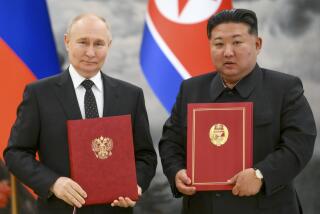The Trans-Pacific Partnership: Who wins, who loses, why it matters
With President Obama set to arrive Wednesday in Tokyo for a summit with Prime Minister Shinzo Abe, thorny issues in the Trans-Pacific Partnership negotiations will be a key subjects. Here are the basics on the TPP:
What is the Trans-Pacific Partnership?
The Trans-Pacific Partnership is a trade pact being negotiated among 12 Pacific Rim countries. The TPP is an ambitious effort to shape a comprehensive agreement that would not only reduce tariffs and other barriers to open markets, but also establish standards on a variety of issues affecting trade and international competition. For instance, negotiators are working to set up rules on intellectual property rights, government procurement and the role of the state in private enterprise.
Which nations are in the TPP and which aren’t?
The dozen countries, in order of economic size, are the United States, Japan, Canada, Australia, Mexico, Malaysia, Singapore, Chile, Peru, New Zealand, Vietnam and Brunei. Together, they account for almost 40% of the global economy. As the largest economy, the U.S. is seen as leading the negotiations.
South Korea has expressed interest in joining, as have Taiwan and the Philippines. China, the world’s second-biggest economy, has been increasingly studying the TPP.
How did the TPP get started?
The negotiations began in talks more than a decade ago among Singapore, Chile and New Zealand. An agreement was reached by those three countries, plus Brunei, in 2005, and it became the model for the TPP and was extended to other nations. The U.S. announced that it would join the discussions in 2008.
What’s in it for the U.S.?
Many analysts generally see liberalizing trade as a benefit to the economy. The TPP has the potential to boost U.S. exports and investments by eliminating or lowering tariffs and leveling the playing field in some large or rapidly growing markets. The White House, citing the think tank Peterson Institute for International Economics, has said the TPP could create more U.S. jobs and generate an additional $123.5 billion a year in U.S. exports by 2025.
Beyond the commercial implications, many experts regard the TPP as a key part of American foreign policy. Amid the rise of China and its increasing exercise of political and military power in East Asia, the Obama administration has said it would turn its attention more to the East to strengthen U.S. influence in that region.
Why is the TPP controversial?
The TPP is the most significant multilateral trade undertaking for the U.S. since the North American Free Trade Agreement 20 years ago. Labor unions and other critics of NAFTA say that deal has pushed American manufacturing operations overseas and cost hundreds of thousands of jobs. The U.S. Chamber of Commerce and other business interests counter that the pact led to booming trade and commercial activity in North America.
Beyond the general dispute over trade agreements, a number of organizations and lawmakers criticize the TPP negotiations for not being transparent enough.
Some groups are worried that the TPP will establish rules that could lead to restrictions on affordable generic medicines in developing countries. Others are concerned that the TPP won’t set very high standards — or the enforcement mechanisms needed — to protect the environment and labor rights.
What are the major sticking points?
Every country has some products that it is particularly sensitive about and wants to protect. The U.S. wants access to Japan’s politically powerful farm sector, including beef and pork. Japan and the U.S. also remain at odds over what both sides see as barriers to each other’s car markets.
Australia and New Zealand, meanwhile, are seeking greater openings for their agricultural and dairy goods, and Vietnam for its textile and footwear exports. Besides car companies, U.S. producers of sugar and textiles, among some others, are concerned that they will suffer from increased foreign competition.
When will negotiations be finished?
TPP negotiators, including Obama’s top trade official, Michael Froman, had set a goal of reaching agreement by the end of last year. But their last meeting in December in Singapore ended without a deal, and it appears they have lost some momentum.
A new target for concluding talks hasn’t been set, and though there are hopes that an agreement will be completed this year, the midterm elections in the U.S. could present more challenges because trade has been a hot political issue in the past. Negotiators are expected to meet again in mid-May in Vietnam.
Will Congress approve it?
The administration is seeking congressional approval for trade-promotion authority. Also called fast-track authority, it would give the president the power to negotiate a trade agreement that Congress can approve with a simple majority and with minimal debate and no amendments.
Typically, Republican lawmakers have supported trade agreements, but it’s unclear whether tea party or other conservative members of the GOP will back the TPP, especially since it is being negotiated by a Democratic White House. Perhaps more challenging for the administration is the reluctance by Democratic lawmakers, especially from strong manufacturing states, to grant the president fast-track authority and throw their weight behind the TPP.
A large bipartisan group in both chambers of Congress has pressed the administration to include a provision in the TPP that would prevent trading partners from engaging in currency manipulation, a touchy subject that top U.S. trade officials have yet to bring to the TPP table.
More to Read
Inside the business of entertainment
The Wide Shot brings you news, analysis and insights on everything from streaming wars to production — and what it all means for the future.
You may occasionally receive promotional content from the Los Angeles Times.











